We Couldnt Add This Spot to Your Saved Restaurants To Try Again Click the Bookmark Icon
Although you can put everything on your website, please don't. Here are 15 things that should never go on a website, under any circumstances.
Disclaimer: Some readers will disagree with this advice. These are my sincere recommendations, but ask your strategist or designer before making big changes to your site.
1. Vague headlines …we're the best, at what?
Homepage headlines often fail to say what the business does. Instead, they offer a general statement about quality or value.
The visitor's first question is "am I in the right place?" The headline should answer this question by explicitly stating the main business category.
Ironically, the "what we do" information is usually just below the headline in smaller text.
Here's an example:
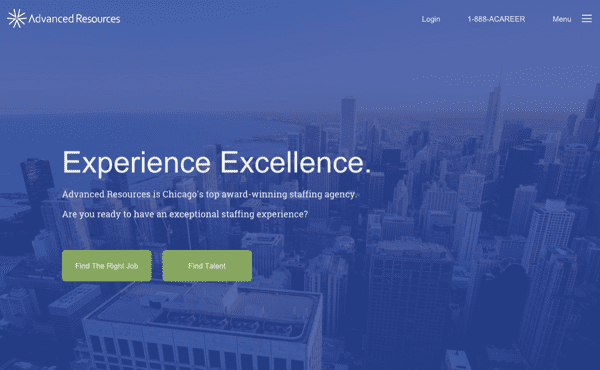
The header "Experience Excellence" is vague. But the text below "award-winning staffing agency" is much more descriptive.
What to do instead:
- Flip the header and subheader if your headline is vague, but the text below is specific.
- Make the headline text descriptive, so every visitor can tell what you do, at a glance, within seconds.
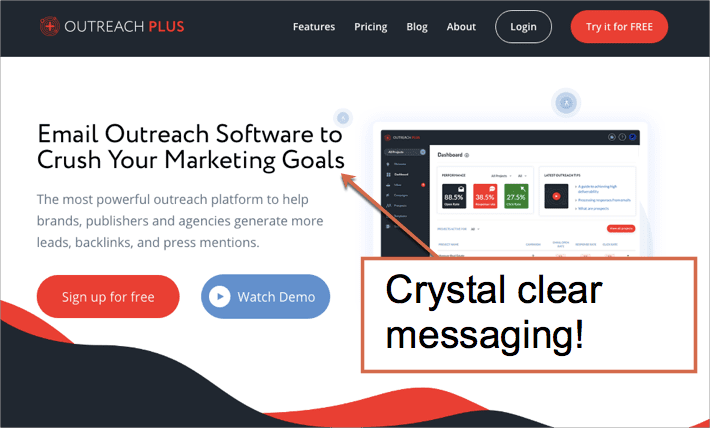
Tip! The Five Second Test
Show your site to a stranger. Count to five then turn off the screen. Now ask them "what did you recall?" If they don't know what you do, your headline is too vague. You just failed the Five Second Test. Usability Hub has created a Five Second Test website, and your first test is free. Give it a shot!
Related: 19 things to put on your home page.
2. Social media icons in your header …candy-colored exit signs
Social media traffic is great, but only if it's flowing toward you. When visitors leave your site and go to a social network, that doesn't help you meet your goals. They are unlikely to return.
Where there's traffic, there's hope. A visitor on your site may subscribe or become a lead. A visitor on YouTube is more likely to watch videos of dogs looking guilty. Surprisingly, 13% of top marketing sites put social icons in their headers.
![]()
Facebook is worth billions. You need the visitors more than they do.
What to do instead:
Link to social networks cautiously. Here are a few guidelines:
- Add social media icons to your website footer, rather than the header.
- Change the color of the icons so they are not so visually prominent. If you show the color, do so on the rollover.
- Link only to social networks where you are genuinely active, both sharing content and interacting with followers
Related: The top 5 social media integration mistakes on websites and how to fix them
3. Meaningless section headers
When parts of a page are broken up into smaller sections, those sections often get their own little headers. These headers are often larger than the items in the section, but far less meaningful. If you have section headers on the pages on your website, ask yourself this question:
If I removed that header, would it confuse visitors?
If the answer is no, then the headers are not meaningful. It's adding visual noise, not value.
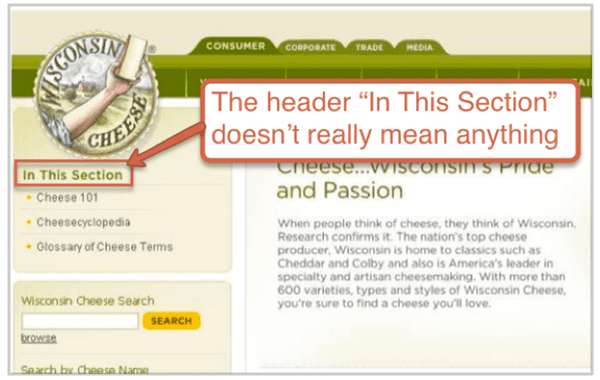
What to do instead:
- Write descriptive headers for sections.
- Or just remove the header completely, making the items in the section more prominent.
4. Dates on the blog
If your content strategy is like mine, you write and share helpful, how-to articles that are useful to your audience …and they don't go out of style. These articles are "evergreen." They time travel well. They'll be just as helpful in a month or a year.
So why add the date?
Adding dates to the blog design or in headlines just makes the content look old later on. If it's not relevant, why show your age?
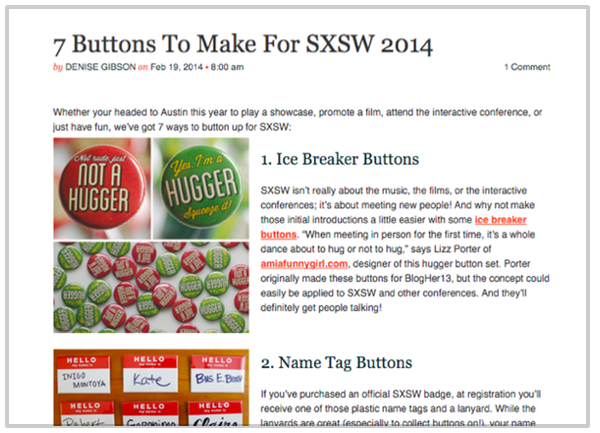
Great little post from our friends who make custom buttons over at Busy Beaver! But it's timeless so why add the year?
What to do instead:
- Remove the date stamp from your blog posts!
- Make sure that the date doesn't appear in URLs or in headlines either.
Related: 13 blog design best practices
5. YouTube suggested videos …#CatFail videos on your site
It's very easy to embed a YouTube video into your website. But be careful. When the video ends, YouTube may suggest other totally unrelated videos. Are visitors watching cat videos on your site?
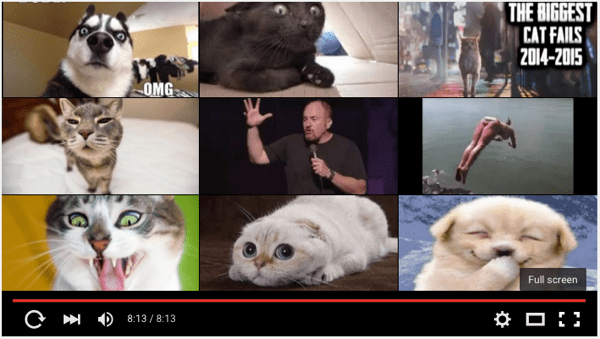
What to do instead:
YouTube doesn't let you turn off suggested videos anymore but there's a way around it. Here's how:
- Create a playlist on YouTube with related videos
- While watching the video on YouTube, click the "share" button under the video
- Now click "embed"
- Copy the embed code. When you add the embed code to your site add "?rel=0" after YouTube embed URL

This will show you related videos from the playlist that you created instead of cat videos.
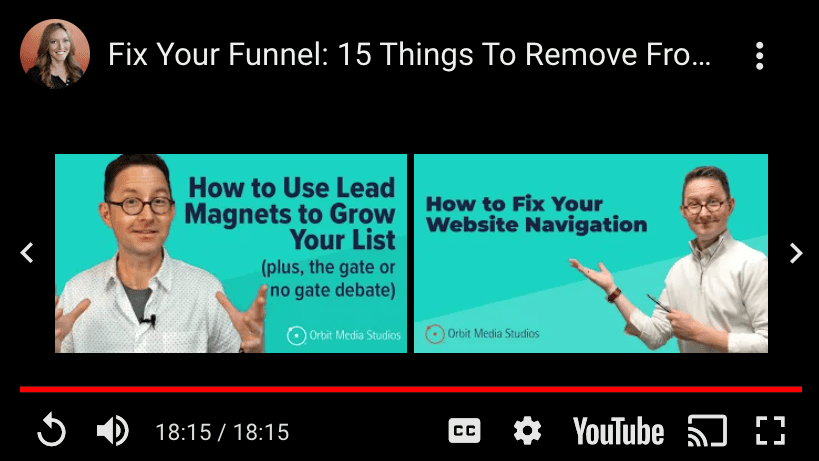
6. Long paragraphs
Some visitors read. All visitors scan. Short paragraphs are one of the best ways to make your content scannable. Compare these two pages.
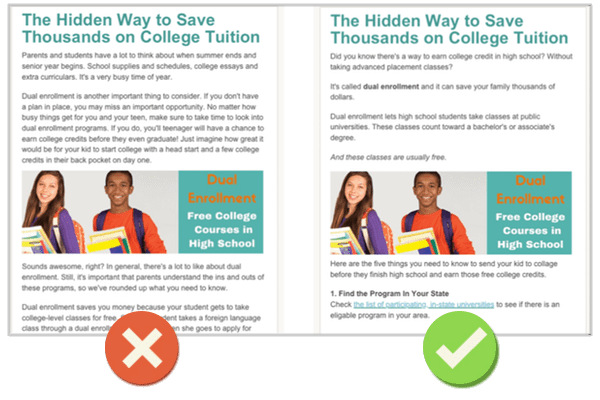
The page with the shorter paragraphs is far more likely to keep the visitor.
What to do instead:
- Never write a paragraph longer than three or four lines.
- Add other formatting to make your content more scannable: bullets, bolding, internal links, etc.
Related: 22-point checklist for website content best practices
7. Stock photos of people …stranger danger
People pictures are powerful because faces are so compelling. From the time we are infants, we gaze at faces more than any other type of images. Every website should have pictures of people.
But visitors can smell a stock image a mile away. And stock images of people are the worst kind. They just don't feel genuine.

Perfect lighting. Spotless office. Ethnically diverse. Casual, but serious. Obviously not real.
What to do instead:
- Invest a bit in photography. Dress up for picture day.
- No budget? Take a selfie. Authentic is more important than polished.
8. Press releases …the insensitive way to publish
A press release is not a blog post. It's not educational or entertaining. It's an announcement, specifically designed for members of the press.
And they aren't typically written for the web. They're just copied and pasted into web pages or uploaded as PDFs (more on PDF files in a minute)
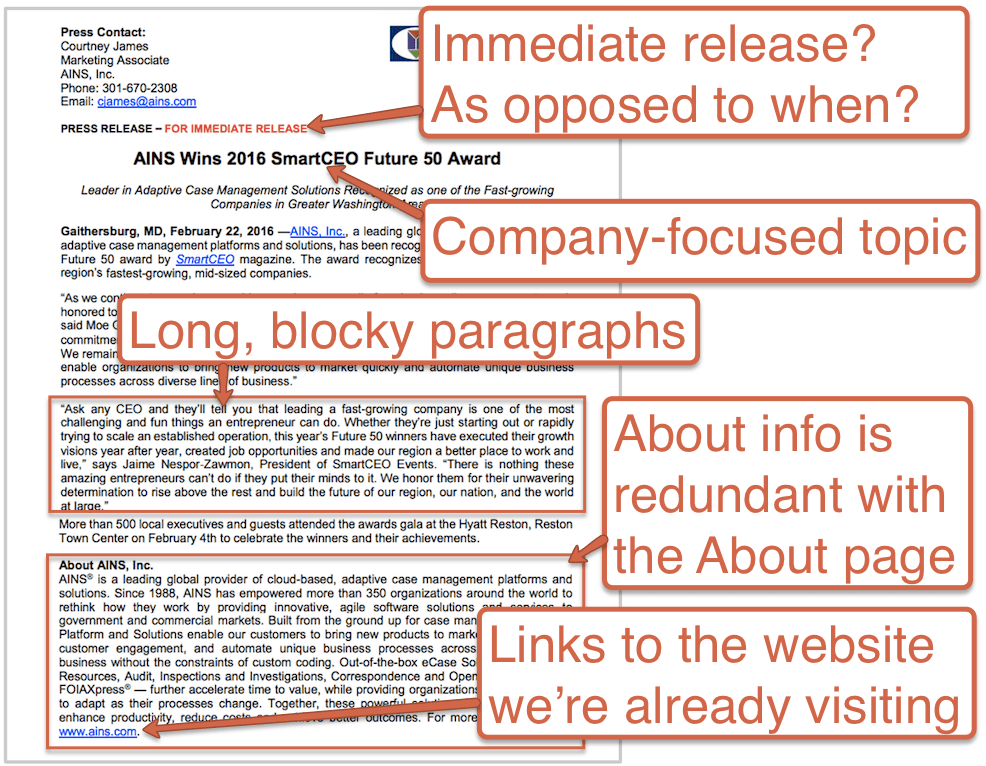
So before you put another press release into your blog or news section, ask a few questions:
- What percentage of your visitors are journalists?
For most sites, it's probably around .01%. It makes you wonder why so many sites have "press" in the main navigation. - How much effort would it take to turn the press release into a nice piece of content?
Does it really need to say "for immediate release?" Do you need to have the company info at the bottom? If it's on your site, why does it link to your site. Is this your best effort to publish good web content? - Do you expect your visitors to find your press release compelling?
Research suggests that they won't. This study shows them to be one of the least persuasive things you can put on your site.
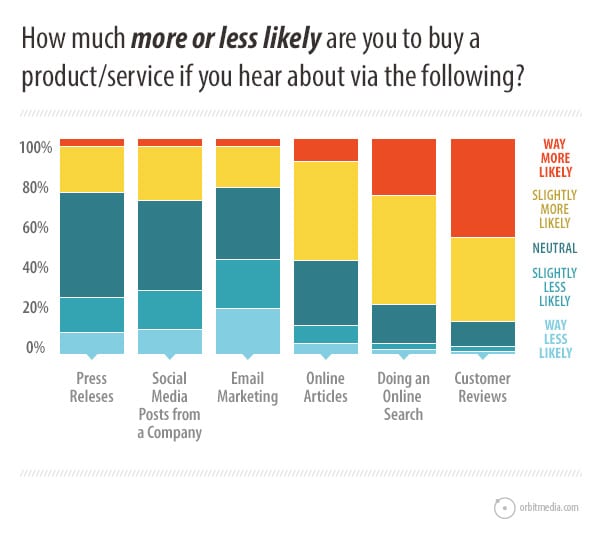
source: MOZ / Fractl
On the other hand, if the media frequently requests information, your website can help. Create a digital press kit with images, downloads and anything else they are asking for. This makes perfect sense since it solves a problem.
What to do instead:
Rewrite your press release as a blog post or news article, adapting it for the web. Include the following elements, which probably weren't part of the original release:
- Images: a featured image with the headline within the image, plus additional images throughout the content
- Formatting: subheaders, bulleted lists, bolding, italics, etc.
- Links: one link to another post, another link to a product or service page
- Marketing: Keywords, mentions from influencers and other calls-to-action
After you've written a nice piece of content, promote the heck out of it. Here are 76 content promotion strategies for your blog.
9. PDF files …the "rust" of the internet
Many of you may disagree, but hear me out. Here's a rundown of pros and cons for PDF files and HTML webpages.
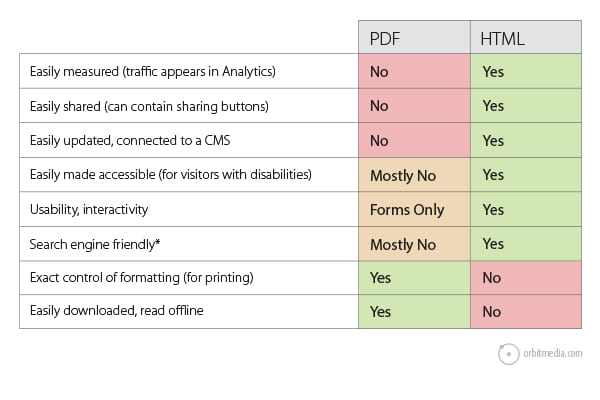
*It's true that PDFs often rank, but usually it's by accident. No serious search optimizer would recommend targeting a competitive phrase with a PDF file.
PDF files are easy to create and upload, so they are an easy fix for content management when sites are hard to update. That's why I call them rust.
Don't get me started on Word Docs. They're even worse! It's a PDF file that can contain viruses.
Does your site have a PDF problem? Here's how to check for rust. Search Google for "site:webaddress.com PDF" and you'll see a count.
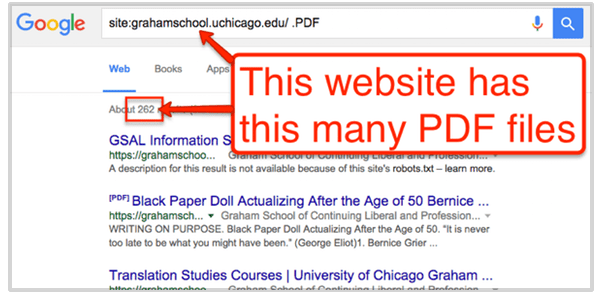
Tip! Want to see how many HTML pages a website has? Just do the same search with -PDF, so search for "site:webaddress.com -PDF" and Google will show you the page count.
What to do instead:
- All content should be HTML pages.
- Use PDFs as an alternate version when information is likely to be printed or downloaded.
10. Ads for your own stuff
We've all conditioned ourselves to look away from ads. If it looks like an ad, we ignore it. It's called "banner blindness." But many website owners still put banner ads for themselves on their websites.
It's the worst way to get visitors' attention.
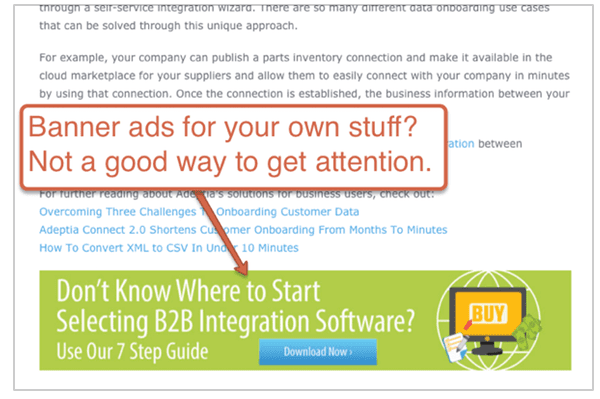
The trend on media sites is to use "native advertisements" which are paid ads disguised to look like content. They're very effective because they don't look like ads.
But a banner ad for yourself on your site is truly native, but you disguised it to look like an ad. That's the opposite of good marketing.
What to do instead:
- Promote your content within your content, native advertising style.
- Add simple, text-based calls-to-action at the bottom of every page.
11. Your testimonials page
Testimonials are "social proof" which is a key aspect of web design and neuromarketing. Smart marketers support every marketing claim with evidence.
But this evidence should be close to the claim, which makes it visible and keeps it in context. If it's far away (on a separate page) and out of context (not specific to any claim) then it's weak social proof.
These pages rarely get visited. Just check your Analytics.
What to do instead:
- Remove your testimonials page.
- Add testimonials to every page of the site! Especially when the quote is relevant to the marketing claim.
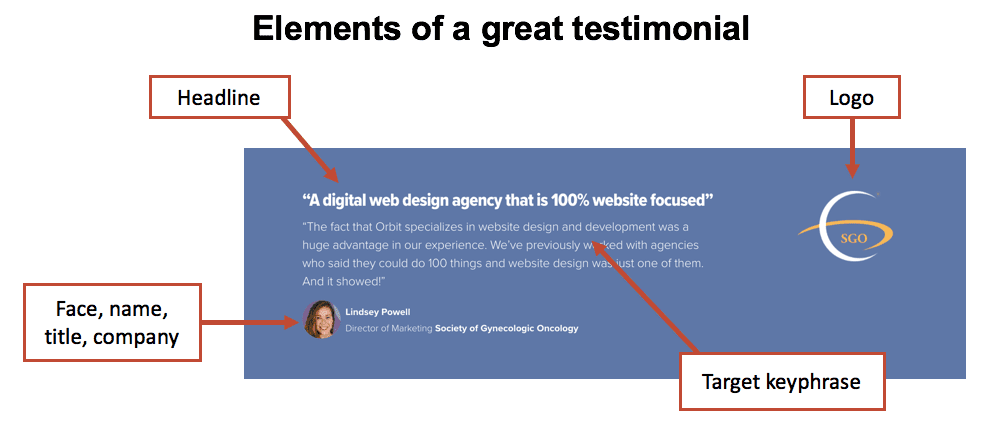
If you need help gathering testimonials, see our complete guide: How to find, write and use persuasive testimonials (plus 10 testimonial examples)
12. Email links …bad for marketing, good for spam
When a visitor gets in touch, you get an email. But was the email sent from a contact form? Or just an email link?
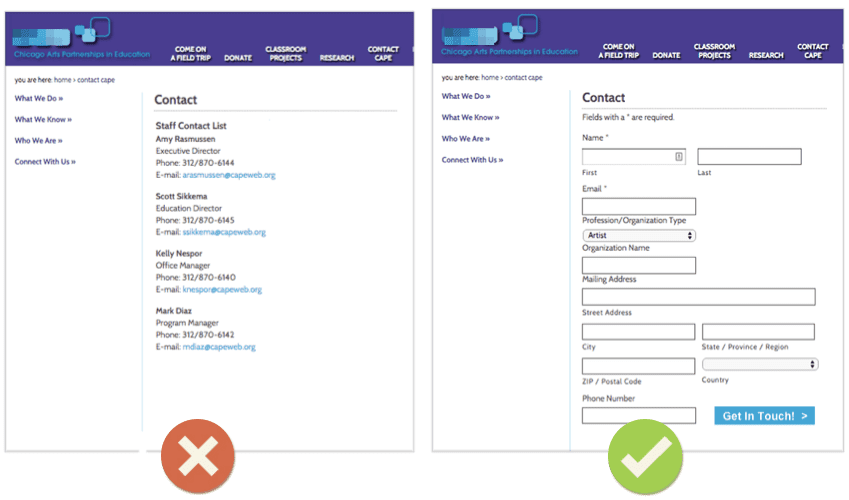
Let's compare.
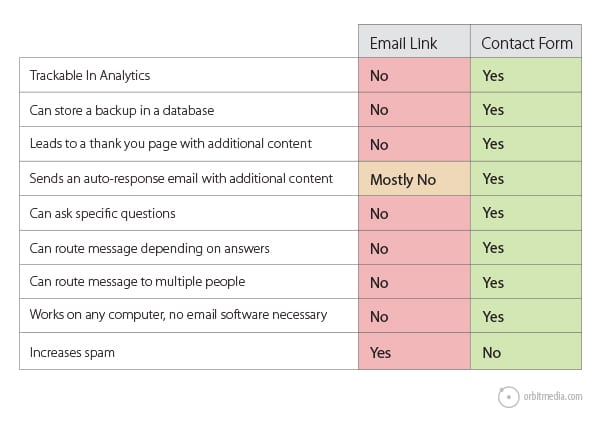
The winner here is obvious. Email links fail on every criterion for good marketing, from messaging to routing, from usability to tracking.
Beyond that, email links are spam magnets. Spammers use robots that scrape the web for email addresses. So that email link on your website is filling up your spam folder.
What to do instead:
- Remove every email link from your website
- Add a simple contact form with a thank you page
- Tell Analytics the address of this thank you page by setting up goals
- Set up an auto-response email, telling your new leads when you'll be in touch
- Make sure your CMS saves a backup of every submission. Email doesn't always get through!
13. Greedy forms
The more you ask for, the less you'll receive. A "greedy form" is a form that asks the visitors for more information that they think they should provide. Example: this form wants you to answer 22 questions to subscribe to a newsletter.
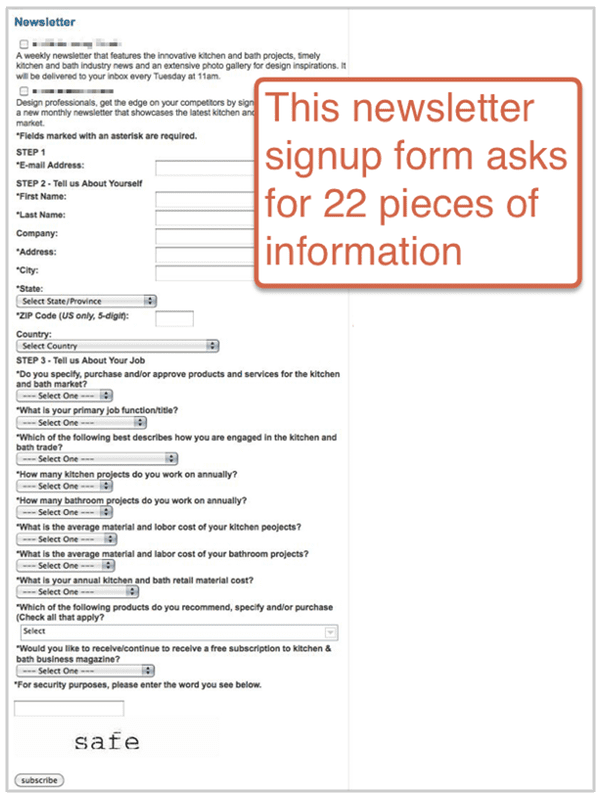
The rule of thumb for conversion optimization: more form fields means a lower conversion rate.
What to do instead:
- Ask for only basic contact information, or the minimum information needed to direct and respond to the lead.
- Ask additional questions over phone or email when you follow up.
14. "Submit" as a Call to Action
A call to action is an opportunity to tell the visitor what benefit they're about to receive. Or, at least, what action they're taking. A good CTA is specific and benefit-driven. A bad call to action says nothing. For example, a button that just says "submit."
The words in that button matter. Just look at these examples.
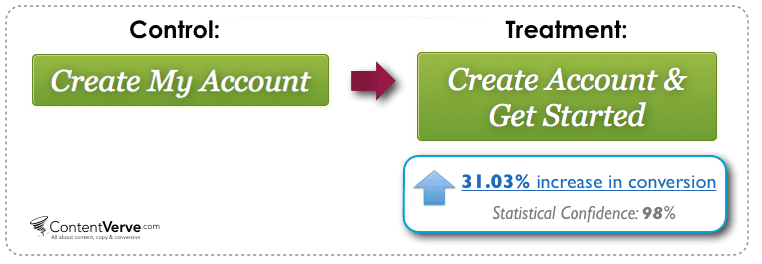

The more descriptive the CTA, the higher the conversion rate. "Submit" says nothing.
What to do instead:
- Highlight the benefit to the visitor in the CTA.
- Use first person voice and descriptive action words.
Related: How to design a button: 7 tips for getting clicked
15. Dead end thank you pages
If your thank you page has just two lonely little words at the top and nothing else, it might as well say "good bye." Right at the peak of their interest, just after they convert …you give them nothing.
But if the thank you page offers the visitor a subsequent action, they're likely to take it.
There is a small newsletter signup form on the thank you page on this website. People subscribe to the newsletter on that page almost every day, adding hundreds of subscribers per year to our email list.

What to do instead:
- Give the visitor another subsequent action by using these thank you page examples.
- Find and fix every dead end on your website and keep visitors flowing.
Make the internet a better place.
You can help! Just share these tips with friends, family and followers…
What did I miss?
I'm sure there are a few more bad ideas we could have included here. What else?
- Vcards
- Music
- QR Codes
- RSS buttons
- Homepage sliders
Want to defend any of the features we added here? Was I totally wrong about anything? Ok, I'm ready. Leave your own rants and input in the comments below.
brouwernounkilthe.blogspot.com
Source: https://www.orbitmedia.com/blog/remove-from-your-site/
0 Response to "We Couldnt Add This Spot to Your Saved Restaurants To Try Again Click the Bookmark Icon"
Post a Comment